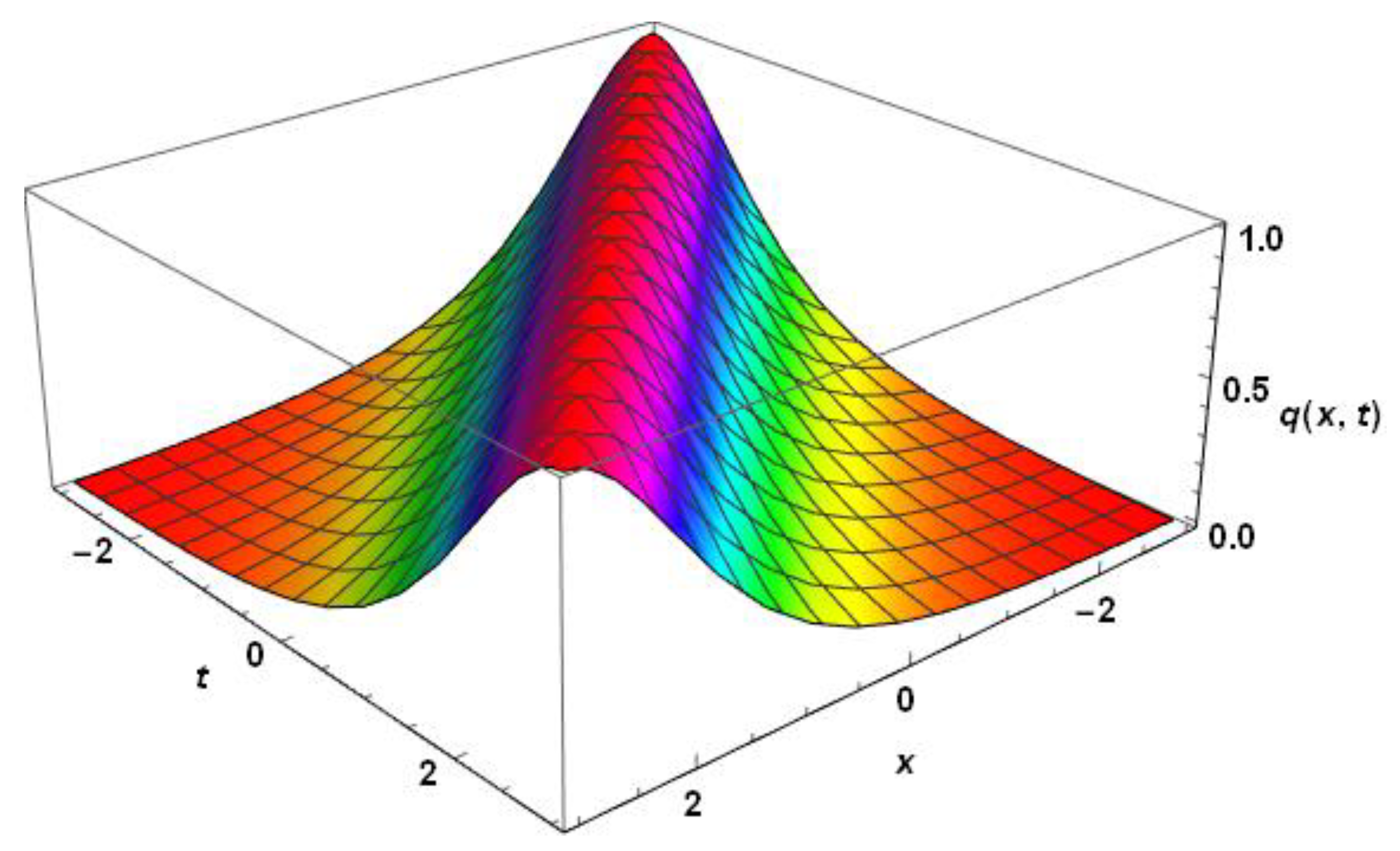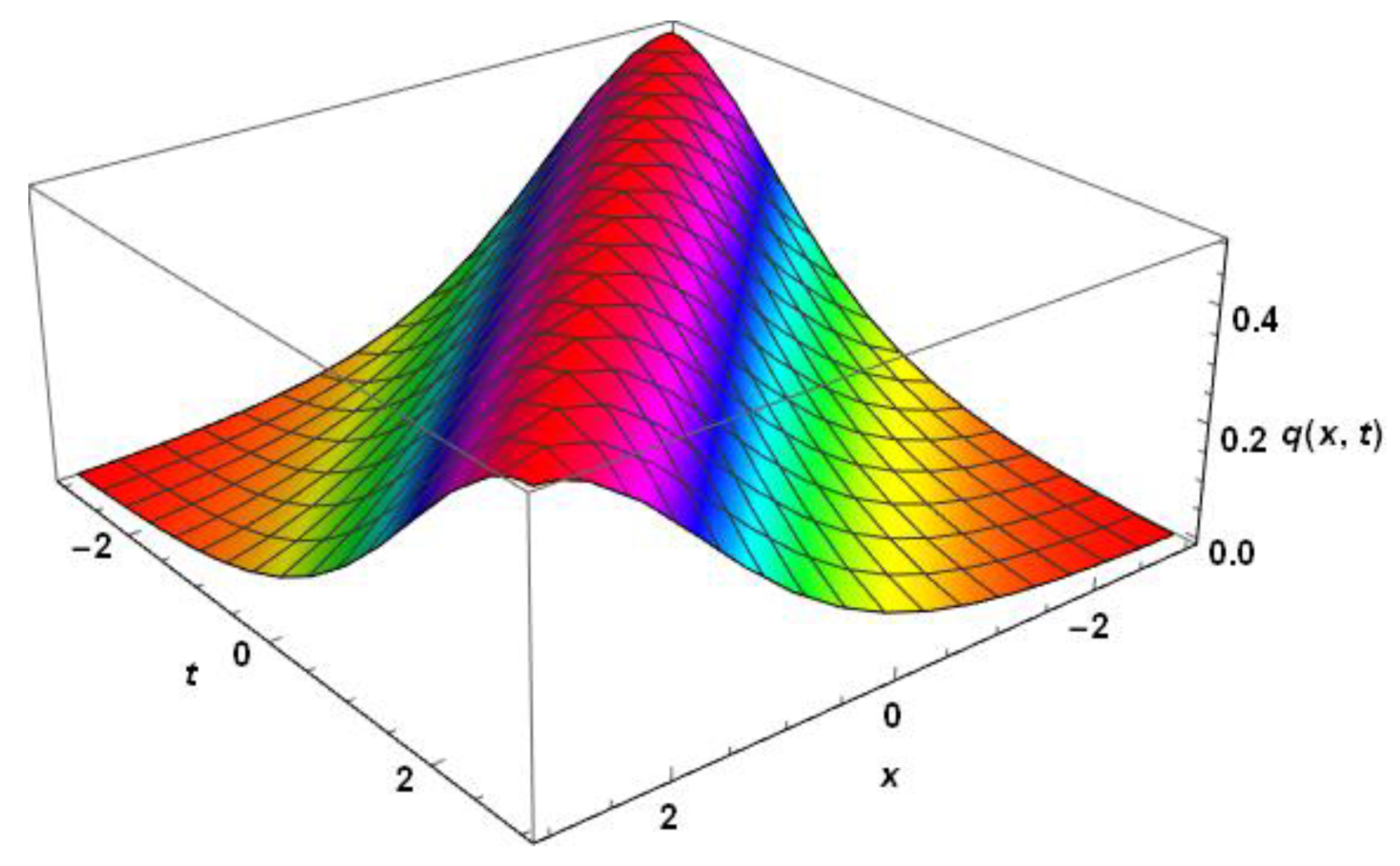Shallow Water Waves and Conservation Laws with Dispersion Triplet
Abstract
:1. Introduction
Governing Model
2. Single Nonlinearity (KdV Equations)
2.1. KdV Equation
Conservation Laws
2.2. Modified KdV Equation
Conservation laws
2.3. Power–Law KdV Equation
Conservation Laws
3. Dual-Nonlinearity (Gardner’s Equation)
3.1. KdV–mKdV Equation
Conservation Laws
3.2. Power–Law Nonlinearity
Conservation Laws
4. Conclusions
Author Contributions
Funding
Institutional Review Board Statement
Informed Consent Statement
Data Availability Statement
Acknowledgments
Conflicts of Interest
References
- Antonova, M.; Biswas, A. Adiabatic parameter dynamics of perturbed solitary waves. Commun. Nonlinear Sci. Numer. Simul. 2009, 14, 734–748. [Google Scholar] [CrossRef]
- Biswas, A.; Kara, A.H. 1–soliton solution and conservation laws for nonlinear wave equation in semiconductors. Appl. Math. Comput. 2010, 217, 4289–4292. [Google Scholar] [CrossRef]
- Biswas, A.; Ismail, M.S. 1–soliton solution of the coupled KdV equation and Gear–Grimshaw model. Appl. Math. Comput. 2010, 216, 3662–3670. [Google Scholar] [CrossRef]
- Biswas, A.; Krishnan, E.V.; Suarez, P.; Kara, A.H.; Kumar, S. Solitary waves and conservation laws of Bona—Chen equation. Indian J. Phys. 2013, 87, 169–175. [Google Scholar] [CrossRef]
- Collins, T.; Kara, A.H.; Bhrawy, A.H.; Triki, H.; Biswas, A. Dynamics of shallow water waves with logarithmic nonlinearity. Rom. Rep. Phys. 2016, 68, 943–961. [Google Scholar]
- Gepreel, K.A. Exact soliton solutions for nonlinear perturbed Schrödinger equations with nonlinear optical media. Appl. Sci. 2020, 10, 8929. [Google Scholar] [CrossRef]
- Girgis, L.; Biswas, A. A study of solitary waves by He’s semi–inverse variational principle. Waves Random Complex Media 2011, 21, 96–104. [Google Scholar] [CrossRef]
- Joseph, R.I.; Egri, R. Another possible model equation for long waves in nonlinear dispersive system. Phys. Lett. A 1977, 61, 429–430. [Google Scholar] [CrossRef]
- Khan, S. Conservation laws of Biswas–Arshed equation in optical fibers (filling in the gap). Optik 2019, 194, 163037. [Google Scholar] [CrossRef]
- Kudryashov, N.A. A note on solutions of the Korteweg–de Vries hierarchy. Commun. Nonlinear Sci. Numer. Simul. 2011, 16, 1703–1705. [Google Scholar] [CrossRef]
- Ma, W. Riemann–Hilbert problems and soliton solutions of nonlocal reverse-time NLS hierarchies. Acta Math. Sci. 2022, 42, 127–140. [Google Scholar] [CrossRef]
- Ma, W. Riemann–Hilbert problems and inverse scattering of nonlocal real reverse--spacetime matrix AKNS hierarchies. Phys. D 2022, 430, 133078. [Google Scholar] [CrossRef]
- Ma, W. Riemann–Hilbert problems and soliton solutions of type (,) reduced nonlocal integrable mKdV hierarchies. Mathematics 2022, 10, 870. [Google Scholar] [CrossRef]
- Masemola, P.; Kara, A.H.; Bhrawy, A.H.; Biswas, A. Conservation laws for coupled wave equations. Rom. J. Phys. 2016, 61, 367–377. [Google Scholar]
- Krishnan, E.V.; Kara, A.H.; Kumar, S.; Biswas, A. Topological solitons, cnoidal waves and conservation laws of coupled wave equations. Indian J. Phys. 2013, 87, 1233–1241. [Google Scholar] [CrossRef]
- Triki, H.; Kara, A.H.; Bhrawy, A.; Biswas, A. Soliton solutions and conservation laws for Gear–Grimshaw model for shallow water waves. Acta Phys. Pol. A 2014, 125, 1099–1106. [Google Scholar] [CrossRef]
- Wazwaz, A.M. Analytic study on the generalized fifth–order KdV equation: New solitons and periodic solutions. Commun. Nonlinear Sci. Numer. Simul. 2007, 12, 1172–1180. [Google Scholar] [CrossRef]
- Wazwaz, A.M. Integrability of coupled KdV equations. Cent. Eur. J. Phys. 2011, 9, 835–840. [Google Scholar] [CrossRef]
- Wazwaz, A.M. New (3+1)–dimensional nonlinear equations with KdV equation constituting its main part: Multiple soliton solutions. Math. Methods Appl. Sci. 2016, 39, 886–891. [Google Scholar] [CrossRef]
- Wazwaz, A.M. Multiple soliton solutions and other exact solutions for a two–mode KdV equation. Math. Methods Appl. Sci. 2016, 40, 2277–2283. [Google Scholar] [CrossRef]





Publisher’s Note: MDPI stays neutral with regard to jurisdictional claims in published maps and institutional affiliations. |
© 2022 by the authors. Licensee MDPI, Basel, Switzerland. This article is an open access article distributed under the terms and conditions of the Creative Commons Attribution (CC BY) license (https://creativecommons.org/licenses/by/4.0/).
Share and Cite
Biswas, A.; Coleman, N.; Kara, A.H.; Khan, S.; Moraru, L.; Moldovanu, S.; Iticescu, C.; Yıldırım, Y. Shallow Water Waves and Conservation Laws with Dispersion Triplet. Appl. Sci. 2022, 12, 3647. https://doi.org/10.3390/app12073647
Biswas A, Coleman N, Kara AH, Khan S, Moraru L, Moldovanu S, Iticescu C, Yıldırım Y. Shallow Water Waves and Conservation Laws with Dispersion Triplet. Applied Sciences. 2022; 12(7):3647. https://doi.org/10.3390/app12073647
Chicago/Turabian StyleBiswas, Anjan, Nyah Coleman, Abdul H. Kara, Salam Khan, Luminita Moraru, Simona Moldovanu, Catalina Iticescu, and Yakup Yıldırım. 2022. "Shallow Water Waves and Conservation Laws with Dispersion Triplet" Applied Sciences 12, no. 7: 3647. https://doi.org/10.3390/app12073647
APA StyleBiswas, A., Coleman, N., Kara, A. H., Khan, S., Moraru, L., Moldovanu, S., Iticescu, C., & Yıldırım, Y. (2022). Shallow Water Waves and Conservation Laws with Dispersion Triplet. Applied Sciences, 12(7), 3647. https://doi.org/10.3390/app12073647









